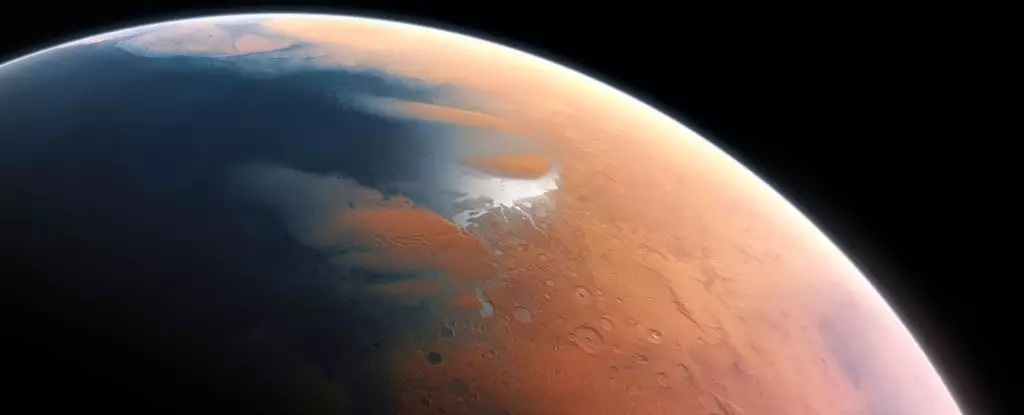The exploration of Mars has long captivated humanity’s imagination, igniting curiosity about the planet’s history and potential for past life. Once celebrated as a neighboring world possibly teeming with life, Mars has since arisen as a dusty, stark desert. Yet, recent studies tell us a different story—one rich in water, leading to conjectures that ancient oceans may have decorated its surface. This article delves into the significance of recent discoveries, exploring the findings that suggest extensive water bodies once shaped Mars, alongside the profound implications these revelations hold for both planetary science and the search for extraterrestrial life.
Evidence of Ancient Water on Mars
Mars, with its parched landscapes and swirling dust storms, appears to be a dry shell of rock—an inhospitable realm. However, a groundbreaking study utilizing data from ground-penetrating radar (GPR) has unveiled features indicative of historical shorelines and rivers. These findings align with evidence showcased in previous research, suggesting that the icy red planet once harbored significant bodies of water, notably a northern sea called Deuteronilus. Geologist Benjamin Cardenas emphasizes this notion, highlighting the discovery of formations that have the appearance of ancient beaches and river deltas—areas where water collected, swelled, and ebbed away in time.
This progressive understanding comes from combining advanced radar measurements conducted by the Chinese National Space Administration’s Zhurong rover with established geological theories. As the rover traversed regions like Utopia Planitia, it produced three-dimensional maps of subsurface features by measuring varying material densities within Martian terrain. Thus, the observations suggest that Mars boasted conditions curiously similar to those of Earth’s coastlines long before becoming the barren landscape we observe today.
Rethinking Mars’ Historical Climate
The climate of ancient Mars prompts endless questions about the volume and persistence of water across its surface. With prior assumptions deemed outdated, scientists are re-evaluating the duration of water presence on the planet, acknowledging a potential millennia-long water cycle. Recent studies propose that this celestial body was not an arid wasteland as previously believed, but instead fostered large water bodies likely shaped by tides and sediment deposition—mechanisms critical for forming transitional environments typical of Earth.
Geophysicist Michael Manga reinforces this assertion by articulating that the newly identified geological structures display orientations suggesting they once functioned as productive, tidal environments. Notably, the morphology of these features—thick layers angled towards a supposed shoreline—echoes what one might find on Earth, suggesting the action of waves and currents sculpted these structures over time. This tantalizing evidence not only signifies the existence of a Martian ocean but opens new dialogue about how extreme climatic shifts transformed Mars from a hospitable planet into its current desolate state.
The existence of ancient oceans on Mars presents tantalizing opportunities in the pursuit of extraterrestrial life. Coastal regions, where water meets land and atmosphere, are thought to be potential hotspots for biotic activity, as seen on Earth in the earliest life forms flourishing in shallow waters. Understanding where Martian shorelines once stood can guide future explorations to the most promising sites for sampling and analysis.
The findings prompt a critical reassessment of the conditions necessary for life to thrive. As scientists outline potential sites of historical habitation, the implications stretch far beyond our nearest planetary neighbor; they redefine criteria for assessing habitability across the solar system. The possibility that primordial Martian environments supported life, or at least the conditions necessary for life formation, fuels the operators of missions such as Perseverance while providing compelling rationale for Mars as a site for astrobiological research.
While the recent study paints a vivid picture of a wetter, more dynamic Martian past, questions remain regarding the current status of water on the planet. Researchers hypothesize that large reservoirs of liquid water may still dwell beneath the Martian surface, hidden from our view. Understanding the hydrology of Mars in its entirety will require a concerted effort to further investigate the implications of ancient seas and the mysterious absence of water today.
As we look toward the future, the urgency of robust exploration missions that can probe beneath the surface deepens. Analyzing these submerged histories could reveal not just the mechanics of Mars’ climate evolution but also whether life ever took hold in the shadows of its ancient shores. Mars beckons with unanswered questions, and the journey into its past may yield some of the most significant discoveries in the ongoing narrative regarding life beyond Earth.
The quest to understand Mars’ aquatic legacy echoes through the corridors of space research, reframing our approach to interplanetary exploration and inviting exciting possibilities in the story of life’s origins across the cosmos.


Leave a Reply